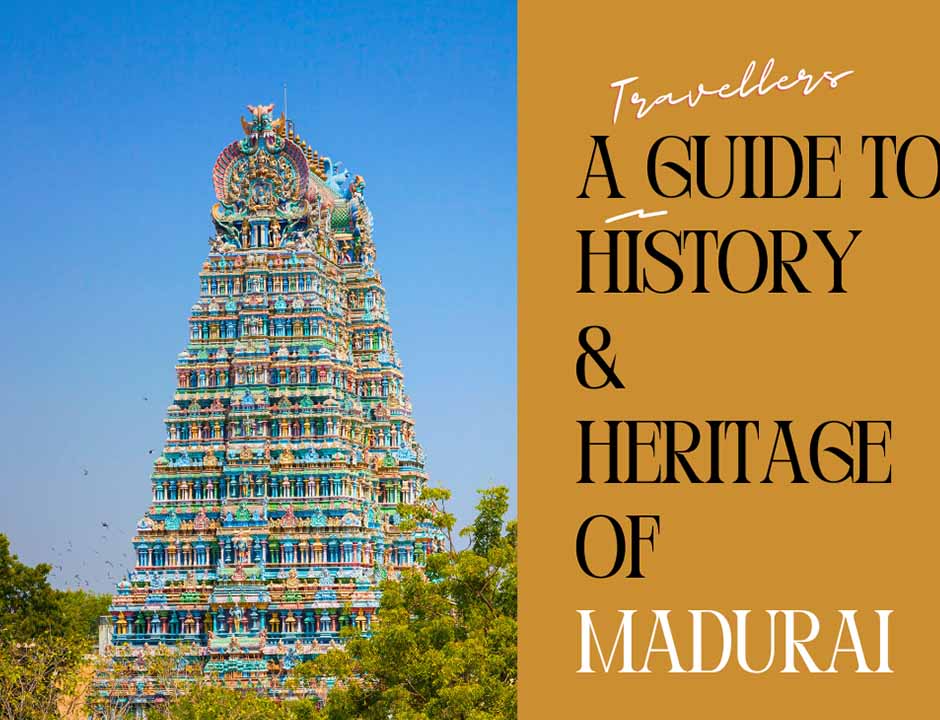A Culture and Heritage Travel Guide on Madurai

Frequently Asked Questions by travellers visiting Madurai
What is the early history of Madurai?
The history of Madurai is linked with the account of the Panday dynasty, one of the four classical kingdoms ( Pandya, Chera, Chola and Pallava) that ruled south India since 300 BCE for more than 1000 years. Madurai was the capital of the Pandyas. Pandays took over Madurai from the Kalabrah dynasty in 590 CE. Pandya Kings who ruled south India from Madurai were powerful rulers, and their regime continued till the 9th century when the Cholas took over the kingdom.
How can you reach Madurai?
Madurai is well connected by air, rail, and road. The city has its own airport, which several domestic airlines serve. The Madurai railway station is linked to major cities across India, making it a convenient option for travellers. The town is also well connected by road, with several state and national highways passing through it.
What are the top seven historical and heritage places you should explore in Madurai?
a. Meenakshi Amman Temple: This iconic temple is one of the most important landmarks in Madurai and is best known for its intricate carvings and sculptures.
b. Thirumalai Nayakkar Palace: Built by the Nayak dynasty in the 17th century, this palace is a prime example of the unique blend of Indian and European styles.
c. Gandhi Memorial Museum: Mahatma Gandhi visited Madurai in 1919. This museum commemorates his visit and is dedicated to his life and legacy. We remember seeing a portion of his blood-stained cloth in the museum.
d. Koodal Azhagar Temple: This ancient temple is dedicated to Lord Vishnu and is known for its beautiful sculptures and carvings.
e. Alagar Koyil: This temple is dedicated to Lord Vishnu and is located on a hill overlooking the city.
f. Vaigai Dam: The dam is a popular tourist spot and offers breathtaking views of the surrounding countryside.
g. Vandiyur Mariamman Teppakulam: This temple tank is one of the largest in South India and is famous for its annual float festival.
What are the other places of tourist interest in Madurai?
Madurai has several other tourist places besides historical and heritage sites. These include the Samanar Hills, the Goripalayam Dargah, the Mariamman Teppakulam, and the Kazimar Big Mosque.
Which is the best time to visit Madurai?
Between October and March. Avoid summer and the rainy seasons.
Which are the best souvenirs you can buy from Madurai?
Madurai is famous for its handloom “Sungudi sarees”, which are available in a wide range of colours and designs. In addition, the city is known for its brassware, wood carvings, and stone sculptures. You can also find traditional handicrafts like baskets, mats, and toys, which make great souvenirs.
What traditional food and drinks must you try while in Madurai?
Madurai is famous for its cuisine, particularly its spicy non-vegetarian dishes. Some of the must-try words include the famous Madurai biryani, kari dosai, kola urundai, and paruthi paal. Though we really enjoyed the Madurai biryani, we never got to taste any vegetarian items. Of all the local foods, the unique one is “Jigarthanda“, a sweet drink you will fall in love with with the first sip.
What are the lesser-known facts about Madurai?
Some people refer to Madurai as the “Athens of the East”. This is due to its rich cultural and intellectual heritage relating to the Sangam poets’ gatherings. Besides that, the city is home to many great poets, scholars, and artists and has a long tradition of fostering intellectual pursuits. Another interesting fact is that Madurai is also one of the oldest continuously inhabited cities in the world. The region has been inhabited for more than 2500 years. Interestingly, recent excavation findings from a place near Madurai may disrupt many earlier notions we positively had about Tamil history.
How many days are required to explore Madurai?
You will need a day to explore Madurai Meenakshi temple, nearby markets, etc. Considering the other places that must be visited, allocating three days will be good.
Is visiting Madurai worth it?
Madurai is slightly detached from the primary heritage circuit of Tamil Nadu. But if you are a cultural traveller, you need to include Madurai in your itinerary.